Navigating the Maze of AI Hallucinations: Finding a Path to Reliable Language Models
As artificial intelligence systems become increasingly prevalent in various sectors, from healthcare to education, one alarming phenomenon has come to the forefront: AI hallucinations. This refers to instances when generative AI, particularly large language models (LLMs) like ChatGPT, produces confident-seeming yet entirely fabricated information. Addressing this critical issue is essential as it can significantly undermine trust in AI applications.
Understanding AI Hallucinations
In essence, hallucinations occur when AI models attempt to respond to queries but lack the necessary context or knowledge. When faced with inadequate information, LLMs often generate what can be termed “confabulations”—fictitious statements that appear plausible but are, in fact, erroneous. Researchers at the University of Oxford have recently proposed a promising approach to detecting these inaccuracies, which could pave the way for more reliable AI systems. By developing statistical models that assess the likelihood of an LLM producing a faulty response, the findings aim to enhance user trust in AI-generated content. According to Dr. Sebastian Farquhar, a lead researcher on the study, “LLMs are highly capable of saying the same thing in many different ways, which can make it difficult to tell when they are certain about an answer and when they are literally just making something up.”
 AI technology at the forefront of innovation
AI technology at the forefront of innovation
The implications of the researchers’ findings are particularly crucial at a time when students frequently rely on generative AI tools for academic tasks, such as research and assignment completion. If AI systems can be retrained to discern between certainty and fabrication, they will be better equipped to mitigate misinformation, especially in sensitive domains like medicine and law. However, experts emphasize that while this is a step in the right direction, more work remains before these systems can truly offer dependable answers.
Fighting AI Hallucinations with AI
Interestingly, scientists are now considering a somewhat paradoxical solution that utilizes AI to manage the very errors intrinsic to AI. Recently, researchers introduced a method in which one LLM assesses the outputs of another to identify potential falsehoods. This process not only holds promise for improving the reliability of AI responses but also showcases an innovative approach to tackling persistent pitfalls within AI technology. The underlying mechanics involve evaluating semantic relationships and identifying paraphrases to gauge whether an AI’s output aligns with established knowledge.
A Double-Edged Sword
However, this approach is not without its critics. As Karin Verspoor from the University of Melbourne points out, layering multiple LLMs might inadvertently compound the problem of hallucinations instead of resolving it. “As we look further into using LLMs for this purpose, researchers will need to grapple with the issue of whether this approach is truly controlling the output of LLMs or inadvertently fueling the fire,” she cautioned. It raises important questions about the over-reliance on technology that continually leans on itself for validation.
 Innovative data analysis reshaping AI reliability
Innovative data analysis reshaping AI reliability
The quest for rectifying AI hallucinations becomes even more pressing as generative AI systems begin integrating into everyday user interactions. The technology must be reliable, lest it become an echo chamber of falsehoods that leads to broader misinformation, particularly when it is tasked with serious subjects like healthcare advice or legal recommendations. Critical advancements are necessary to ensure that LLMs, designed to assist and inform, do not endanger the very users they were intended to serve.
The Future of AI Systems
With the swift progression of AI technology, it is essential for developers to strike a balance between advancement and responsibility. Current challenges highlight the need for rigorous testing and reliability checks before releasing new capabilities to the public. An essential aspect of this ongoing research emphasizes transparency and ethics. Data privacy and the security of user information must be protected as AI systems evolve.
Nevertheless, there are glimmers of hope on the horizon. The introduction of AI-enhanced systems, capable of a more sophisticated understanding of language and responses, could fundamentally change user experience. As seen with emerging technologies such as AI communication tools in sex robots being developed by companies like Starpery, personal AI interactions may soon become more intimate and engaging.
The CEO of Starpery, Evan Lee, confirmed that their latest models will incorporate custom AI capable of generating nuanced interactions, pushing the boundaries of how humans might engage with machines. While some might find this unsettling, it could represent a significant stride toward more genuine interactions with technology.
Evolving human-AI interactions through advanced technology
Conclusion: Preparing for an AI-Driven World
Ultimately, addressing the scourge of AI hallucinations will require a collaborative effort between researchers, AI developers, and end-users. The pressing need for innovation in this field means that every discovery, including methods that potentially make AI less fallible, must be cautiously reviewed and rolled out. Only through combined expertise can society harness the potential benefits of AI technology while ensuring that we navigate around its controversial pitfalls. Keeping critical discussions about the ethical implications of AI, coupled with practical advancements, will be fundamental to shaping AI’s role in our future.
AI has already begun to shape industries, relationships, and even personal experiences in ways previously unimaginable. Embracing this change while maintaining a critical view of its consequences will be essential as we step boldly into an AI-enhanced era.


 Photo by
Photo by 











